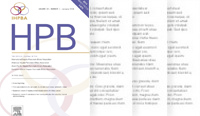International Hepato-Pancreato-Biliary Association
HPB Blog, December 2014

The December issue of HPB is like a Christmas hamper - full of quality and with a pleasing variety of gifts. Pancreatic disease is addressed by a paper from Louisville looking at the importance of the hepatic artery lymph node on outcomes from pancreatic cancer, which shows that involvement of this lymph node is not an independent predictor of outcome and so shouldn’t rule people out of resectional surgery. On the theme of pancreatic resection, a non-randomised ‘expertise’ based analysis of outcomes from McGill University showed similar pancreatic fistula rates from pancreatic jeunostomy compared with pancreatic gastrostomy reconstruction, with the strap-line message; stick to what you are good at doing.
In a separate study, an analysis of costs of pancreaticoduodenectomy showed that high volume centres not only offered lower mortality rates but were also significantly less expensive for this major procedure. Money was also considered in a study from John’s Hopkins that compared patients undergoing synchronous bowel and liver resection for colorectal cancer with patients undergoing staged separate procedures. They found that synchronous resection was associated with 6 days fewer in hospital and significant financial savings with equivalent long-term outcomes. Putting the financial prudence aside, the reduced hospital stay should be a big selling point from a patient-centred approach.
Age is a minor theme of the December issue with two papers showing excellent outcomes for selected over 70 year old patients undergoing liver transplantation and a separate study showing great tolerability of radioembolization for colorectal hepatic metastases in the elderly.
A large study from Duke University examined the National Surgical Quality Improvement Program (NSQIP) database with respect to surgical site infection in HPB procedures. They found considerable heterogeneity in how procedures were classified with many ‘clean-contaminated’ procedures being wrongly miscoded as ‘clean’ or alternatively as ‘dirty’. This may seem like semantics but surgical site infection rates can seem better or worse depending on the accuracy of coding and since this information is likely to be made publicly available it is important for institutions in the USA to get this right in what is a competitive market.
It is always good to have a puzzle at Christmas to ponder in between the festivities. This year a paper from Baylor University, Dallas has reported that biliary complications after liver transplantation appear to be related to hepatic artery flow rate per kg body weight of the recipient. I am sure we can all understand the association between hepatic artery flow and biliary complications but significant influence of the recipient’s body weight in determining complications is more difficult to understand. Baylor have of course proposed some possible explanations but readers are welcome to consider the data themselves and submit their own thoughts either as a letter to the editor or through MyHPB.
The December issue of HPB remains essential reading for the HPB surgeon and in addition to what I have featured also contains further articles on classification of cholangiocarcinoma, HPB training and technique in laparoscopic liver resection. 2014 has seen the journal impact factor rise to over 2 for the first time and with your support through the submission of high quality articles in our specialty and the citation of our articles, we will see this climb further over the coming years. From all of the Editors, Editorial Board and backroom staff of HPB we wish you happy holidays, a Merry Christmas and a productive and prosperous New Year.
To view the table of contents, click here
Stephen J Wigmore,
Corporate Partners
If you are interested in becoming a Corporate Partner of the IHBPA please contact industry@ihpba.org
Find out more


